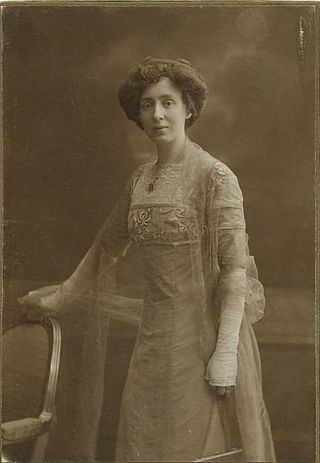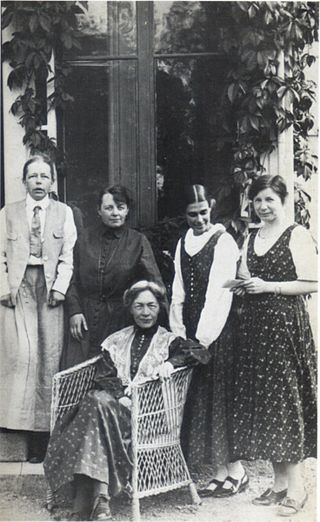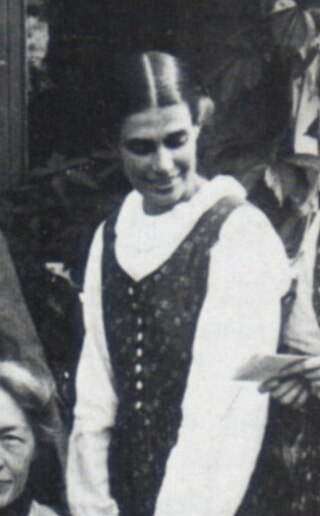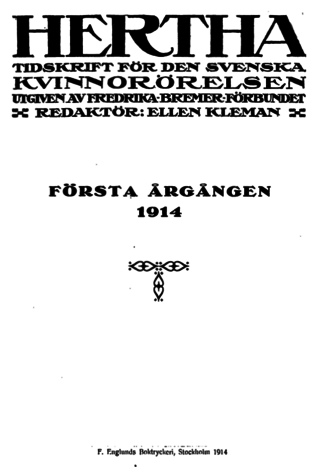
Early general elections were held in Sweden between 10 and 26 September 1921. It was the first elections held under universal suffrage, for both men and women. The Swedish Social Democratic Party remained the largest party, winning 93 of the 230 seats in the Andra kammaren of the Riksdag. Party leader Hjalmar Branting formed his second government.

Kerstin Hesselgren was a Swedish politician. Hesselgren became the first woman to be elected into the Upper House of the Swedish Parliament after female suffrage was introduced in 1921. She was elected by suggestion of the Liberals with support from the Social democrats.
The titles hovsångare for men and hovsångerska for women are awarded by the Swedish monarch to a singer who, by their vocal art, has contributed to the international standing of Swedish singing. The formal title was introduced by King Gustav III of Sweden in 1773, with the first recipients being Elisabeth Olin and Carl Stenborg. The position as such, however, dates back to the 17th century, when Anne Chabanceau de La Barre and Joseph Chabanceau de La Barre were singers at the court of Queen Christina of Sweden.

Agda Maria Östlund, née Lundgren was a Swedish Politician of the Social Democrats. She was one of the first four women to be elected to the Swedish parliament after the introduction of women suffrage.

Elisabeth Tamm was a Swedish liberal politician and women's rights activist. She was known in the parliament as Tamm i Fogelstad.

Anna Fredrika "Frigga" Carlberg, née Anna Fredrika Lundgren, was a Swedish writer, social worker, feminist and advocate for women's suffrage. She was a member of the central committee of the National Association for Women's Suffrage from 1903 to 1921 and chair of the Gothenburg branch of the Swedish Society for Woman Suffrage from 1902 to 1921.

Nelly Maria Thüring , was a Swedish photographer and politician. She was one of the first five women elected to the Swedish parliament in 1921.

The status and rights of Women in Sweden has changed several times throughout the history of Sweden. These changes have been affected by the culture, religion and laws of Sweden, as well as social discourses like the strong feminist movement.

Ellen Helga Louise Hagen was a Swedish suffragette, women's rights activist and politician. She was a member of the National Association for Women's Suffrage, the chairperson of Liberala kvinnor in 1938–1946 and Svenska Kvinnors Medborgarförbund in 1936–1963. During the 1920s and 1930s, she was internationally active within peace work and the Swedish delegate in the international peace conference in Paris in 1931.

Helga Frideborg "Frida" Maria Stéenhoff, née Wadström, was a Swedish writer and women's rights activist. She was a leading participant of the public debate of gender equality and a contributor of several radical progressive publications. She was engaged in the women suffrage movement and several humanitarian organisations.

Kvinnliga medborgarskolan vid Fogelstad was a Swedish education center for women, active from 1922 until 1954. The purpose of the center was to educate women about their newly affirmed rights and responsibilities as citizens after women suffrage had been achieved in 1921.

Eva Johanna Andén was a Swedish lawyer. She became the first woman member of the Swedish Bar Association on 14 March 1918.
Hjördis Levin is a Swedish historian and author whose field of research focuses on gender studies.

Ada Konstantia Nilsson was an early Swedish woman medical doctor. She was one of the founders of the campaigning magazine Tidevarvet in 1923.

Honorine Hermelin was a Swedish headteacher, magazine founder and feminist.

Herta Elisabet Svensson (1886–1981) was a Swedish educator, social worker, and personnel consultant. She was an important figure in the history of social work and settlement movement in Sweden, and was part of the initiative that established the country's first settlement house Birkagården in 1912. In 1921, she became the first person in Sweden to hold the title "personnel consultant". While working for the Svenska tobaksmonopolet, she actively volunteered to uplift the living conditions of workers and established a convalescent home in Värmland.

Hertha is a Swedish-language women's magazine published by the Fredrika Bremer Association, named after Swedish writer and feminist Fredrika Bremer's novel Hertha. It has been in circulation since 1914.
Rösträtt för kvinnor was a journal published by the Swedish National Association for Women's Suffrage. It was first published in 1912 and the last issue was published in 1919, when the Riksdag decided to extend universal suffrage to men and women. The journal's motto was: "We can never do as much for a great cause as a great cause can do for us."
Pennskaftet is a 1910 novel by the Swedish writer Elin Wägner.















